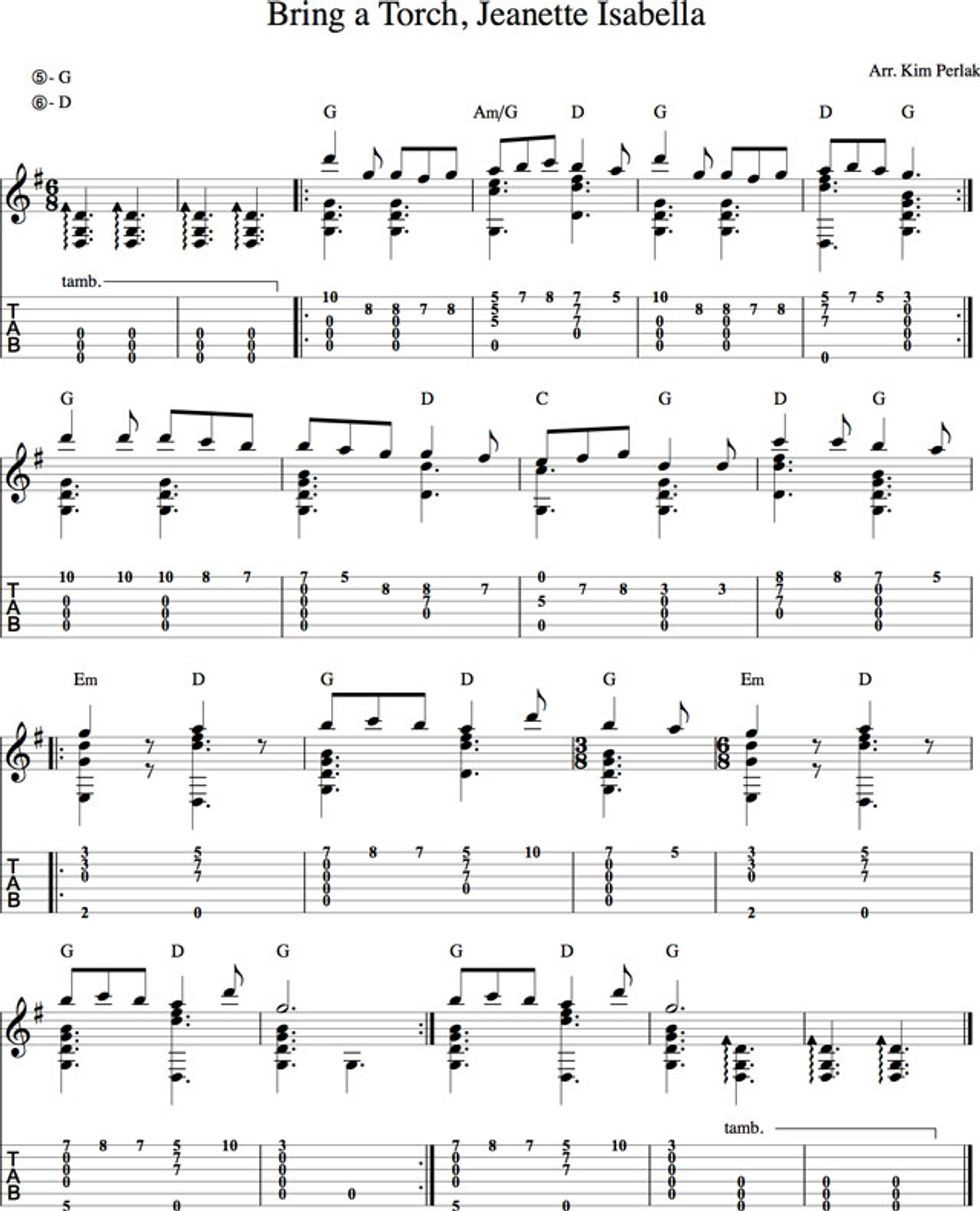Learn this 16th-century French Christmas carol, in dropped D-plus-G tuning.
Chops: Intermediate
Theory: Beginner
Lesson Overview:
• Unlock new sounds with dropped D-plus-G tuning.
• Learn about the tambura technique.
• Create rich and droning voicings for common chords.
Click here to download a printable PDF of this lesson's notation.
Altered tunings provide an easy way to develop a new view of the fretboard. Probably the most common non-standard tuning is dropped-D, but by simply changing one more string, new musical doors will open. Dropped–D-plus–G tuning provides a rich harmonic palate for the lilting pulse and elegant melody in this arrangement of the 16th-century French carol, “Bring a Torch, Jeanette Isabella.” This carol about preparations for the first Christmas reminds me of my grandmother singing this tune to herself during the holidays as she danced around the kitchen. This arrangement recalls the lightness of her spirit as she glided from task to task and brings out the happy excitement of the song.
To get this effect, practice crisp, full rolls of the chords with a metronome to establish rhythmic buoyancy that will carry the tune. Work on the clarity of your tone on the treble strings and your legato playing to bring the melody to life.
Begin by tuning the 6th string to D and the 5th string to G. This creates an open G chord on the lower five strings of the guitar. Overall, this will give your instrument a warm, rich sound—and it will allow you to use more open strings in the chord voicings.
The arrangement opens with a rhythmic drone in the bass. To play the first beat, sweep the bass strings quickly with your thumb. This will be particularly effective if you have a thumbnail. The next three beats are played with the tambura technique. As the first chord is ringing, strike the open bass strings close to the bridge with your right-hand thumb by holding your hand open and flicking your wrist.
In the body of the arrangement, each of the chords is meant to be rolled so the melody notes fall on the beat. Use your thumb to sweep the bass strings, and roll your index, middle, and ring fingers (i, m, and a for classical players) on the trebles. To fatten up the melody notes, tilt your forearm towards the body of the guitar to support your ring finger as you roll.
In general, the A section of the tune should have a stately, “on the beat” feel. The beginning of the B can move forward in the beginning of the first two phrases, and pull the tempo back with some rubato (relaxation of strict time) at the end of each. The third and fourth phrases of the B section begin with two quarter-note chords, each followed by an eighth rest. Be sure to “play” the rest by stopping the strings with your right hand!
Depending on which French translation you find, this little stop-time comes on the lyric, “Hark! Hark!” or “Hush! Hush!” (It was also the moment when my grandmother would rock into a pause in her little dance on the tips of her toes or gesture upwards with her hands.) “Playing” the rest will give your performance the same lilting effect, if you do it in time.
Repeat the arrangement as many times as you’d like, and then I’ve suggested repeats in the score and in the recording that create a “fade out” effect for the ending. Hang on to that last high note as long as you’d like. Finally, end as you began—with a tambura that slows as it fades out.

 Guitarist Kim Perlak has been recognized as an inspired voice in new American music. Her playing was praised by The Austin-American Statesman as, “thoughtful, enchanting, vivid … a songwriter’s circle without the lyrics.” Her performances of new classical works and collaborations with jazz and traditional players have been featured on National Public Radio and on CBS’ Sunday Morning, at the Yale Guitar Extravaganza and the National Guitar Workshop, and in concert halls across the nation. For more information, visit kimperlak.com.
Guitarist Kim Perlak has been recognized as an inspired voice in new American music. Her playing was praised by The Austin-American Statesman as, “thoughtful, enchanting, vivid … a songwriter’s circle without the lyrics.” Her performances of new classical works and collaborations with jazz and traditional players have been featured on National Public Radio and on CBS’ Sunday Morning, at the Yale Guitar Extravaganza and the National Guitar Workshop, and in concert halls across the nation. For more information, visit kimperlak.com.
